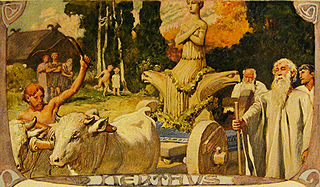
In Greek mythology, Styx is a deity and a river that forms the boundary between Earth and the Underworld. The rivers Acheron, Cocytus, Lethe, Phlegethon, and Styx all converge at the center of the underworld on a great marsh, which sometimes is also called the Styx. According to Herodotus, the river Styx originates near Feneos. Styx is also a goddess with prehistoric roots in Greek mythology as a daughter of Tethys, after whom the river is named and because of whom it had miraculous powers.

Hindu mythology are narratives found in Hindu texts such as the Vedic literature, epics like Mahabharata and Ramayana, the Puranas, the regional literatures like Periya Puranam. Hindu mythology is also found in widely translated popular texts such as the Panchatantra and Hitopadesha, as well as Southeast Asian texts.

Chinese mythology is mythology that has been passed down in oral form or recorded in literature in the geographic area now known as "China". Chinese mythology includes many varied myths from regional and cultural traditions. Chinese mythology is far from monolithic, not being an integrated system, even among just Han people. Chinese mythology is encountered in the traditions of various classes of people, geographic regions, historical periods including the present, and from various ethnic groups. China is the home of many mythological traditions, including that of Han Chinese and their Huaxia predecessors, as well as Tibetan mythology, Turkic mythology, Korean mythology, and many others. However, the study of Chinese mythology tends to focus upon material in Chinese language.

The indigenous peoples of the Americas comprise numerous different cultures. Each has its own mythologies. Some are quite distinct, but certain themes are shared across the cultural boundaries.

Classical mythology, Classical Greco-Roman mythology, Greek and Roman mythology or Greco-Roman mythology is both the body of and the study of myths from the ancient Greeks and Romans as they are used or transformed by cultural reception. Along with philosophy and political thought, mythology represents one of the major survivals of classical antiquity throughout later Western culture. The Greek word mythos refers to the spoken word or speech, but it also denotes a tale, story or narrative.

Germanic mythology consists of the body of myths native to the Germanic peoples The category includes Norse mythology, Anglo-Saxon mythology, and Continental Germanic mythology. It was a key element of Germanic paganism.

Persian mythology are traditional tales and stories of ancient origin, all involving extraordinary or supernatural beings. Drawn from the legendary past of Iran, they reflect the attitudes of the society to which they first belonged - attitudes towards the confrontation of good and evil, the actions of the gods, yazats, and the exploits of heroes and fabulous creatures. Myths play a crucial part in Iranian culture and our understanding of them is increased when we consider them within the context of Iranian history.

Age of Mythology (AoM) is a real-time strategy video game developed by Ensemble Studios and published by Microsoft Game Studios. It was released on October 30, 2002 in North America and a week later in Europe.
Baltic mythology is the body of mythology of the Baltic people stemming from Baltic paganism and continuing after Christianization and into Baltic folklore. Baltic mythology ultimately stems from Proto-Indo-European mythology. The Baltic region was one of the last regions of Europe to be Christianized, a process that occurred from the 15th century and into at least a century after. While no native texts survive detailing the mythology of the Baltic peoples during the pagan period, knowledge of the mythology may be gained from Russian and German chronicles, later folklore, by way of etymology, and comparative mythology.

In mythology, and in the study of folklore and religion, a trickster is a character in a story, which exhibits a great degree of intellect or secret knowledge, and uses it to play tricks or otherwise disobey normal rules and conventional behaviour.

Greek mythology is the body of myths originally told by the ancient Greeks and a genre of Ancient Greek folklore. These stories concern the origin and the nature of the world, the lives and activities of deities, heroes, and mythological creatures, and the origins and significance of the ancient Greeks' own cult and ritual practices. Modern scholars study the myths in an attempt to shed light on the religious and political institutions of ancient Greece and its civilization, and to gain understanding of the nature of myth-making itself.

Norse mythology is the body of myths of the North Germanic peoples, stemming from Norse paganism and continuing after the Christianization of Scandinavia, and into the Scandinavian folklore of the modern period. The northernmost extension of Germanic mythology, Norse mythology consists of tales of various deities, beings, and heroes derived from numerous sources from both before and after the pagan period, including medieval manuscripts, archaeological representations, and folk tradition.
Myth is a folklore genre consisting of narratives or stories that play a fundamental role in a society, such as foundational tales or origin myths. The main characters in myths are usually gods, demigods or supernatural humans. Stories of everyday human beings, although often of leaders of some type, are usually contained in legends, as opposed to myths.

Celtic mythology is the mythology of Celtic polytheism, the religion of the Iron Age Celts. Like other Iron Age Europeans, the early Celts maintained a polytheistic mythology and religious structure. For Celts in close contact with Ancient Rome, such as the Gauls and Celtiberians, their mythology did not survive the Roman Empire, their subsequent conversion to Christianity and the loss of their Celtic languages. It is mostly through contemporary Roman and Christian sources that their mythology has been preserved. The Celtic peoples who maintained either political or linguistic identities left vestigial remnants of their ancestral mythologies that were put into written form during the Middle Ages.












